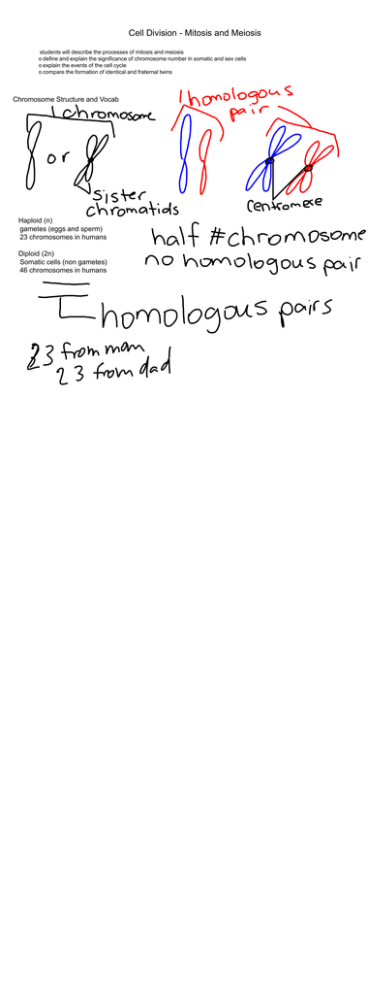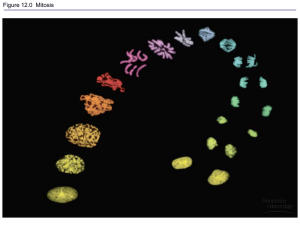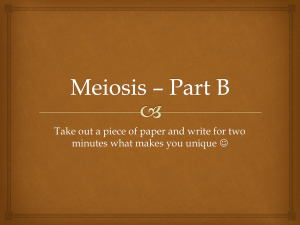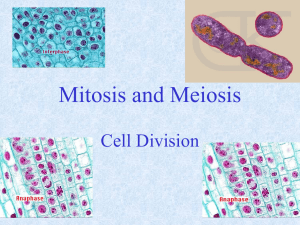
Cell Division - Mitosis and Meiosis
students will describe the processes of mitosis and meiosis
o define and explain the significance of chromosome number in somatic and sex cells
o explain the events of the cell cycle
o compare the formation of identical and fraternal twins
Chromosome Structure and Vocab
Haploid (n)
gametes (eggs and sperm)
23 chromosomes in humans
Diploid (2n)
Somatic cells (non gametes)
46 chromosomes in humans
The Cell Cycle
Growth and division of somatic cell
How multicellular organisms grow in size
Two phases: Interphase and Division Phase
Division Phase
Cell Cycle
Interphase
Longest phase in the cell cycle
Cell grows in size
Doubles cytoplasmic organelles
Duplicates chromosomes
Three parts: G1, S, G2
o G1: cell growth
o S: synthesis of DNA (chromosome duplication
o G2: cell growth and preparation for division
Division Phase
Mitosis and Cytokinesis
Cell splits into two identical cells
Interphase
Mitosis
4 stages: Prophase, Metaphase, Anaphase, Telophase
Prophase
o Chromosomes condense
o Centrioles form and move to opposite ends of cell
o Spindle fibers form and attach to centromeres
o Nuclear membrane starts to dissolve
Metaphase
o Chromosomes (sister chromatids) move to center of cell (equatorial plate)
o Nuclear membrane completely dissolved
o Chromosomes most visible at this stage
o Chromatids can become intertwined
Anaphase
o Centromeres divide
o Sister chromatids (now separate chromosomes) move to opposite ends of cell
o Should be identical chromosomes at each end
Telophase
o Chromosomes lengthen (expand)
o Spindle fibers dissolve
o Nuclear membrane reforms around each group of chromosomes
Cytokinesis
Cytoplasm divides
End with two identical cells
o Both still 2n
Mitosis and Aging (pg 562 and 570 in text)
Limited # of divisions
Biological clock may regulate # of cell divisions allowed
Study on heart cells
Specialization affects mitosis rate
o More specialized cells divide fewer times
Telomere (cap at end of chromosome) controls # of divisions
o In normal cells: telomeres shorten every time the cell divides until it can’t shorten anymore without affecting the
chromosome. Cell is at max age and dies
Telomere
Black bands represent genes
o In abnormal cells: cell keeps dividing and chromosome shortens = lose genetic information = abnormal cells
o In cancer cells: telomeres don’t shorten with each division, so cell never stops dividing
This is due to the presence of enzyme telomerase in cancer cells that prevents shortening of telomeres.
Cloning
Forming identical offspring from a single cell or tissue in the parent organ
Clone and parent have identical DNA
Happens naturally in nature (pg 565)
o Budding
o Runners
o Identical twins
Allows for production of strains of plants with predictable characteristics
Animal Cloning (1960s +)
Frog cloning (pg 567)
o Blastocyst nucleus inserted into enucleated (no nucleus) egg cell
o Egg cell divides mitotically to develop into normal embryo and then frog
o New frog is genetically identical to original embryo
o Nucleus from older cells (gastrulation stage) did not work as well - cells already too specialized to undergo mitosis
Mammal cloning
o Same process as frogs
o Only seemed to work with nucleus from blastocyst cells
o Then Dolly happened
o Took nucleus from adult cells (udder cells) of Finn Dorsett and put in enucleated egg cell of Poll Dorsett
o New embryo (with transplanted nucleus) put into surrogate sheep’s womb (Scottish Blackface)
o Lamb was born that was genetically identical to first adult (Finn Dorsett)
Review questions
Pg 571: #1-4
students will describe the processes of mitosis and meiosis
o describe the process of meiosis and the necessity for the reduction of chromosome number
o compare the processes of mitosis and meiosis
o describe the processes of crossing over and nondisjunction
Meiosis
cell division to form sex cells (aka gametes, sperm, eggs)
happens only in testes and ovaries
gametes are haploid (n)
goes through 2 divisions similar to Mitosis
starts with G1, S, G2
Meiosis I
homologous pairs separate
Prophase I
o Nuclear membrane dissolves
o Centrioles form and move to opposite ends
o Spindle fibers form and attach to centromeres
o Synapsis occurs: homologous pairs come together and intertwine
o (tetrad = 4 chromatids)
o Crossing over may occur (pieces of chromatids break off and exchange) = variability in offspring
Synapsis
Metaphase I
o Tetrads line up on equatorial plate
** For simplicity, I will assume no crossing over happened for the
next stages**
Anaphase I
o Homologous chromosomes separate to opposite ends (segregation)
o Chromosome number has now been reduced to n
**Which ones (red or blue) go left or right is
completely random for each pair. **
Telophase I
o Nuclear membrane forms around each set
o These two new cells are not identical (unlike in mitosis) because one has one set of the homologous pair and the
other has another set.
Cytokinesis
o Cell membrane separates and you are left with two new haploid cells
o Then both start Meiosis II without going through G1, S, G2
Meiosis II
Sister chromatids separate (like in mitosis)
Prophase II
o Nuclear membrane dissolves
o Centrioles form and move to opposite ends
o Spindle fibers form and attach to centromeres
Metaphase II
o Sister chromatids line up on equatorial plate
Anaphase II
o Sister chromatids separate to opposite ends
o Chromosomal number is still haploid
Telophase II
o Nuclear membrane forms around each set
o These two new cells should be identical if there was no crossing over previously.
Cytokinesis
o Cell membrane separates and you are left with four new haploid gametes
students will describe the processes of mitosis and meiosis
o describe the diversity of reproductive strategies by comparing the alternation of generations in a range of organisms
Key Terms
Sporophyte: structure that releases spores - Diploid
Spores: grow into gametophyte
Gametophyte: structure that makes gametes - Haploid
Know the vocabulary and which
ones are diploid or haploid.
Don't have to know specific
plants.
Abnormal Meiosis
Nondisjunction
o 2 homologous chromosomes fail to separate during meiosis or mitosis
o 1 daughter cell has too many, 1 has too few chromosomes
o chromosomes
o Too much or too little, don’t function properly
o More consequences in meiosis = fetus that’s missing or has too many chromosomes
Polyploidy
o More than 2n (nondisjunction of all chromosomes)
o 3n triploidy
o 4n tetraploidy
Failure of 2n zygote to divide after replicating (4n embryo)
o Common and chemically encouraged in plants such as wheat, oats, tobacco, and potatoes
Humans and nondisjunction
o Split at meiosis II produces gametes of 22 and 24 chromosomes (instead of normal 23, 23)
o Therefore after fertilization with a normal gamete, you get embryo of either 45 or 47
1 chromosome where there should be 2 = monosomy
3 chromosomes where there should be 2 = trisomy
As individual develops, every cell will either be 1 short or have 1 too many
Disorders
Down Syndrome
Turner Syndrome
Klinefelter syndrome
Trisomic female










